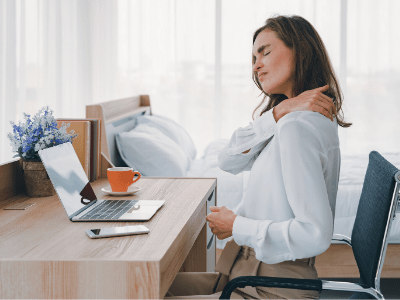Work Ergonomics

Rotator Cuff Injury
July 26, 2019
Returning to the Gym
July 23, 2020Work Ergonomics

Work From Home Ergonomics
As 2020 flicks over to the second half of the year, half of us are back in the office, and the rest of us are still working from home.
From the ergonomic office chair and stand up desk to the awkward dining table and chair with piled up cookbooks and magazines, the quick transition has forced us to be creative.
Here at City Physio, we have seen a range of injuries walking through the door from stiff necks and tight backs, to wrist and thumb injuries. So what’s the common denominator? … most likely your desk set up!
Sitting for long periods of time may be leading to all sorts of disagreements in the body, typing on your laptop sitting too high or too low can result in a natural slump, poked neck, hunched shoulders and lumbo pelvic dysfunction.
Let’s start from the top and work our way down.
Ergonomic Monitors
Monitors should be positioned so that your eyes are two thirds of the way up the screen. If you have more than 1 monitor, position yourself so you are central to your computer screens and angle them slightly towards you. This promotes a resting neutral posture where your head and neck are centred. Ideally, you want to feel as though your head is ‘floating’ on top of your neck and stacking over your spine. Commonly we see a lot of poked neck postures, where the anterior (front) muscles of the neck including scalenes and sternocleidomastoid are thickened and tight. Due to this overload, we forget about the extensors at the back of the neck, which help lengthen the spine and hold your head up!
Separate keyboard & mouse
When using a laptop, a separate keyboard allows you to have improved mechanics at the shoulders, elbows and wrists. Positioning your keyboard so that your elbows and shoulders are ‘relaxed’ means that your muscles such as your scapular stabilisers (upper trapezius, serratus anterior, rhomboids, levator scapulae) and anterior chest muscles (pectoralis minor) aren’t overloaded or overworked.
Having a separate keyboard and mouse also forces your hands and wrist to be in a neutral position. De Quervain’s has been a common injury at City Physio for desk workers. It is the inflammation of the two tendons that run on the side of the thumb. With improved wrist and hand positioning, this complex will be offloaded and less irritated.

Seat position
Choosing the right chair can be a tricky and tedious process, but it is one of the most critical parts to your desk set up. There are 35 muscles attached to the pelvis (the bony frame at the base of the spine), if you are sitting for the majority of the day, you want every muscle to be doing its job. To aid with this, you want to have sufficient lumbar spine support and a slight anterior tilt at the pelvis. You can use a rolled-up towel or pillow to help you sit upright and tall and ensure a neutral spine. Investing in a swivel chair will also allow you to look at various points on your desk and avoid sitting in a rotated posture.
Analyse your posture by 10am, you would most likely be slouched over your computer. Forcing your shoulders to fall into a forward rotation causes your anterior pectoral muscles to shorten and tighten. Our bodies like to take the path of least resistance which means they favour muscles that are already active and continue to load them up. In the short term, you might not even notice shortening muscles, given they aren’t causing pain symptoms however over time, your body will fall into this posture during your everyday activities such as looking at your phone, going to the gym, riding on the bus and eventually become your ‘norm’.
Watch this video on how to set up your desk and let’s get on to those niggles before it becomes the bane of your existence! Small adjustments can significantly improve how your body functions. Here at City Physio, we can help assess, treat and advise you on how to adjust your body to these ever changing and unpredictable situations.
Claudia Lee
